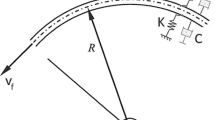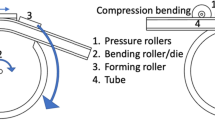Abstract
In this paper, we study the effect of elastic constraint on the deformation of a dilatant material when an irreversible shear causes a change in volume. Two cases are considered: the constraint is caused by elastic ties external to the body and by an elastic core in the dilatant material itself. The first case is considered within the framework of a model problem, whereas the second case is considered by the problem of torsion of a round bar where the outer plastically deformable layers are compressed by the inner elastic core. The Drucker–Prager criterion is used as a yield criterion in the torsion problem.




Similar content being viewed by others
REFERENCES
S. A. Ambartsumyan, Bimodulus Theory of Elasticity (Nauka, Moscow, 1982).
E. V. Lomakin, ‘‘Constitutive relations of the deformation theory for dilatant bodies,’’ Izv. Akad. Nauk SSSR. Mekh. Tverd. Tela, No. 6, pp. 66–75 (1991).
E. V. Lomakin ‘‘Nonlinear deformation of materials whose resistance depends on the type of stress state,’’ Izv. Akad. Nauk SSSR. Mekh. Tverd. Tela, No. 4, pp. 92–99 (1980).
J. Rice, ‘‘On the stability of dilatant hardening for saturated rock masses,’’ J. Geophys. Res. 80, 1531–1536 (1975). https://doi.org/10.1029/JB080i011p01531
J. W. Rudnicki and J. Rice, ‘‘Conditions for the localization of deformation in pressure-sensitive dilatant materials,’’ J. Mech. Phys. Solids 23, 371–394 (1975). https://doi.org/10.1016/0022-5096(75)90001-0
A. Dragon and Z. Mróz, ‘‘A continuum model for plastic-brittle behaviour of rock and concrete,’’ Int. J. Eng. Sci. 17, 121–137 (1979). https://doi.org/10.1016/0020-7225(79)90058-2
H. Park and J.-Yo Kim, ‘‘Plasticity model using multiple failure criteria for concrete in compression,’’ Int. J. Solids Struct. 42, 2303–2322 (2005). https://doi.org/10.1016/j.ijsolstr.2004.09.029
L. D. Wesley, Fundamentals of Soil Mechanics for Sedimentary and Residual Soils (John Wiley & Sons, New York, 2009). https://doi.org/10.1002/9780470549056
E. I. Shemyakin, ‘‘Questions of strength of solid bodies and rocks,’’ in Problem of Solid Mechanics and Mechanics of Rocks: Collection of Papers to the 75th Birthday of E. I. Shemyakin, Ed. by D. D. Ivlev and N. F. Morozov (Fizmatlit, Moscow, 2006), pp. 26–45.
A. Sakharov, E. Karulin, A. Marchenko, M. Karulina, and P. Chistyakov, ‘‘Mechanism of shear collapse in sea ice,’’ in Proc. 25th Int. Conf. on Port and Ocean Engineering under Arctic Conditions (POAC 2019, Delft, 2019). https://www.poac.com/Papers/2019/pdf/POAC19-006.pdf.
W. Prager and P. G. Hodge, Theory of Perfectly Plastic Solids (Wiley, New York, 1951).
H. Saeki, T. Ono, N. En Zong, and N. Nakazawa, ‘‘Experimental study on direct shear strength of sea ice,’’ Ann. Glaciol. 6, 218–221 (1985). https://doi.org/10.3189/1985AoG6-1-218-221
D. C. Drucker and W. Prager, ‘‘Soil mechanics and plastic analysis or limit design,’’ Q. Appl. Math. 10, 157–165 (1952). https://doi.org/10.1090/qam/48291
E. V. Lomakin, ‘‘Torsion of cylindrical bodies with varying strain properties,’’ Mech. Solids 43, 502–511 (2008). https://doi.org/10.3103/S0025654408030217
E. Kamke, Differentialgleichungen reeller Funktionen, Vol. 2: Gewöhnliche Differentialglecihungen, 4th ed. (Akademische Verlagsgesellschaft, Leipzig, 1962).
Funding
The work is supported by the Russian Foundation for Basic Research, project no. 20-01-00356, and by the Research and Educational School on Fundamental and Applied Studies of Space of the Lomonosov Moscow State University.
Author information
Authors and Affiliations
Corresponding authors
Ethics declarations
The authors declare that they have no conflicts of interest.
About this article
Cite this article
Sakharov, A.N., Izimov, R.M. Torsion of a Circular Solid Cylinder Made of Dilatant Material. Moscow Univ. Mech. Bull. 77, 99–109 (2022). https://doi.org/10.3103/S0027133022040057
Received:
Published:
Issue Date:
DOI: https://doi.org/10.3103/S0027133022040057




